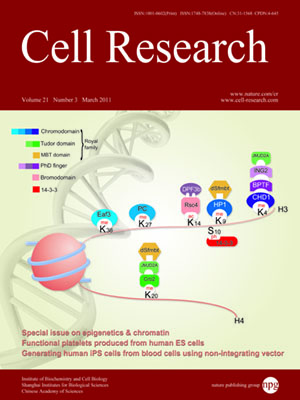
Volume 21, No 3, Mar 2011
ISSN: 1001-0602
EISSN: 1748-7838 2018
impact factor 17.848*
(Clarivate Analytics, 2019)
Volume 21 Issue 3, March 2011: 530-545
ORIGINAL ARTICLES
Platelets generated from human embryonic stem cells are functional in vitro and in the microcirculation of living mice
Shi-Jiang Lu1,3,*, Feng Li1,3,*, Hong Yin1, Qiang Feng1,3, Erin A Kimbrel1,3, Eunsil Hahm2, Jonathan N Thon5, Wei Wang1, Joseph E Italiano5, Jaehyung Cho2 and Robert Lanza1,4
1Stem Cell and Regenerative Medicine International, 33 Locke Drive, Marlborough, MA 01752, USA
2Department of Pharmacology and Anesthesiology, University of Illinois at Chicago, 835 South Wolcott Avenue, Chicago, IL 60612, USA
3Department of Applied Bioscience, Cha University, Seoul, Korea
4Advanced Cell Technology, 33 Locke Drive, Marlborough, MA 01752, USA
5Vascular Biology Program, Department of Surgery, Children's Hospital, and Division of Hematology, Brigham and Women's Hospital, Harvard Medical School, 1 Blackfan Circle, Boston, MA 02115, USA
Correspondence: Shi-Jiang Lu, Jaehyung Cho, Robert Lanza,(jlu@steminternational.com; thromres@uic.edu; rlanza@advancedcell.com)
Platelets play an essential role in hemostasis and atherothrombosis. Owing to their short storage time, there is constant demand for this life-saving blood component. In this study, we report that it is feasible to generate functional megakaryocytes and platelets from human embryonic stem cells (hESCs) on a large scale. Differential-interference contrast and electron microscopy analyses showed that ultrastructural and morphological features of hESC-derived platelets were indistinguishable from those of normal blood platelets. In functional assays, hESC-derived platelets responded to thrombin stimulation, formed microaggregates, and facilitated clot formation/retraction in vitro. Live cell microscopy demonstrated that hESC-platelets formed lamellipodia and filopodia in response to thrombin activation, and tethered to each other as observed in normal blood. Using real-time intravital imaging with high-speed video microscopy, we have also shown that hESC-derived platelets contribute to developing thrombi at sites of laser-induced vascular injury in mice, providing the first evidence for in vivo functionality of hESC-derived platelets. These results represent an important step toward generating an unlimited supply of platelets for transfusion. Since platelets contain no genetic material, they are ideal candidates for early clinical translation involving human pluripotent stem cells.
Cell Research (2011) 21:530-545. doi:10.1038/cr.2011.8; published online 11 January 2011
FULL TEXT | PDF
Browse 1976


